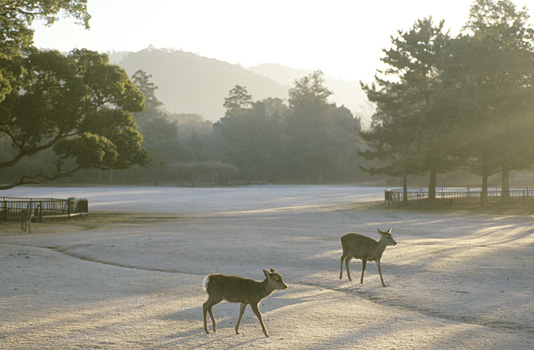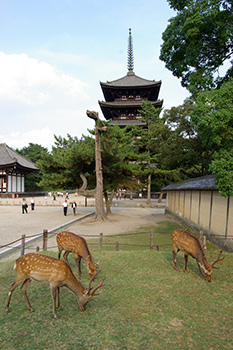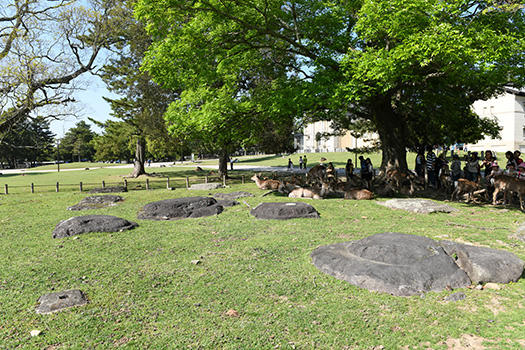

Around 1000 AD, Kyoto (Heian-kyo), the capital of Japan at the time, enjoyed its golden age of classical culture, during which court ladies such as Sei-Shōnagon and Murasaki-Shikibu created their literary masterpieces. Fujiwara Yukinari (also known as Kōzei) was a nobleman in this age, and famous for his calligraphy. He was also well acquainted with Fujiwara Michinaga, the person in power at the time, and recorded the court events in his diary called Gonki. The following quotation includes the first mention of the deer of Nara.
15th day [1st month, 3rd year of the Kankō era] (February 15, 1006, Julian); At 10 a.m., I departed for Kasuga [Shrine]. When I crossed Kowata [present-day Uji city], it began to rain. At dusk in the rain, I arrived at Ninjō’s house [in Nara; Ninjō was a monk of the Kōfuku-ji Temple].
16th day; I purified myself in the early morning. Before visiting the Shrine, I took note of my thoughts. When I entered the Shrine, a pheasant chirped. During my prayer, a crow perched on the third main shrine. Then upon my exit from the Shrine, I encountered deer. These are all good omens. At 6 p.m., I returned home to Kyoto.— From Gonki by Fujiwara Yukinari
In the above description, deer are mentioned in the same sentence as pheasant and crow.
 |
 |
In the following quotation from Fujiwara Munetada’s diary in 1112 AD, deer are referred to in particular.
16th day [6th month, 3rd year of the Ten-ei era] (July 11, 1112, Julian); I traveled to Nara to examine the location of Kasuga Shrine pagoda, which the Regent [Fujiwara Tadazane] is planning to build...
17th day; At 10 a.m., after getting dressed, I visited Nan’en-do to light a lamp and donate scriptures. Then, I inspected the pagoda of the [Kōfuku-ji] Temple because the planned pagoda was to be modeled it. Having called Jakushū, the carpenter monk of the Temple, I had him take measurements of the pagoda. Accompanied by the head of the Temple, the head of the Shrine, and several other people, I examined the location of the planned pagoda within the forest of the Shrine. In order to show it to the Regent, I marked on a map a few locations for the pagoda, where it could be built without felling any trees. During our activity, 40 or 50 deer appeared from the forest and from the direction of the Shrine, and began to accompany us. Believing that this was really a very good omen and a sign from the gods, the monks of the Temple expressed their delight. I returned to my accommodation at 2 p.m...— From Chūyūki by Fujiwara Munetada.
Kujo (Fujiwara) Kanezane was a nobleman from the lineage of the Fujiwara Regental Family. During the time he lived, the government of the aristocratic class in Kyoto was declining and that of the warrior class was on the rise. His diary called Gyokuyō is famous for providing us with records of the transition from classical to medieval times and specifically of the Jishō-Juei War (1180–1185; also known as the Gempei War) fought by the Minamoto and Taira warrior clans. The following quotation from his diary in 1177 is of his daughter’s two-day trip to Nara for her first visit to Kasuga Shrine. At this time, Kanezane’s wife and son (Yoshitsune) accompanied her, and several noblemen served as the escorts.
26th day [2nd month, 3rd year of the Angen era] (March 27, 1177, Julian); Clear weather, then cloudy in the afternoon. The party of my daughter returned home [to Kyoto] at 8 p.m. [According to the report] today, they first visited the Shrine at 4 a.m.... Next, they visited Tōdai-ji, then returned to the accommodation. After having a meal, they departed Nara at 10 a.m. During their trip, they had no problem. Although it rained two days ago prior to the trip, it was clear and calm yesterday and today. Moreover, during their visit to the Shrine, many deer appeared in the morning darkness. These are all signs from the gods and good omens. It is said that when one encounters deer, he or she should get out of the carriage and bow to the first one. Accordingly, the boy [Yoshitsune] got out of the carriage and bowed [to the deer]...
— From Gyokuyō by Kujo Kanezane.
From the above descriptions, we realize that deer inhabiting the forest around Kasuga Shrine were venerated as messengers of the gods in the 11th and 12th centuries. After Minamoto Yoritomo (the first Shogun) defeated the Taira clan in the Jishō-Juei War and established the warrior government in Kamakura in 1185, Kanezane ascended to the highest position (i.e., Regent) in the government in Kyoto with Yoritomo’s support in 1186. As the head of the Fujiwara clan, he worked on rebuilding Kōfuku-ji, which had been destroyed in an attack led by the Taira in 1181. The following quotation describes an event that unfolded during the reconstruction of the temple.
22nd day [8th month, 5th year of the Bunji era] (October 3, 1189, Julian); Clear weather. On this day, I traveled to Nara to worship the Bodhisattva [Fukū-kensaku Kannon] of Nan’en-dō, and to inspect the building of the Temple. According to precedent, the head of the clan should visit the Temple soon after the framework-raising... After entering through the western gate, I walked around passing the northeastern temporary building and the site of the middle gate. Then, I visited the middle hall. At that moment, a deer appeared from inside the hall and ran westward. It was so miraculous that I cannot describe it in words. I was momentarily bewildered, then joined my hands and bowed to the deer. Everyone attending the ritual was moved to tears. Anyone who travels to Nara to visit the Shrine considers encountering deer as a good omen. Anyone who meets with a happy event sees this sign. Generally, encountering deer is confined to the hills and wilderness because they tend to avoid humans. Although, since yesterday, the precincts of the Temple had been crowded by the people who prepared the ritual, among the crowd, appearing from the hall, a messenger of the gods sent a lucky signal to the head of the clan. Embarrassed and delighted at the same time, I shed tears. In spite of my incompetence, I have always worshipped the Temple and the Shrine. Is it the reason why I was rewarded with this miracle?...
— From Gyokuyō by Kujo Kanezane.
From the modern perspective of the above description, we can suppose that “the miracle” had been prepared by the monks of Kōfuku-ji to delight their patron. It might be possible to imagine that the deer of Nara had become tame by that time, as they are today.
 |
 |
|
| Pagoda of Kōfuku-ji and deer. | Foundation stones of the pagoda of Kasuga Shrine. | |
| Kōfuku-ji was the tutelary temple of the Fujiwara clan and had influence over politics, economy and culture throughout the classical and medieval times. | Today, the pagoda site is located in the precincts of Nara National Museum. This pagoda was dedicated by Fujiwara Tadazane in 1116. Also, there is another pagoda site there. It was dedicated by Emperor Toba in 1140. |
Extending eastward from Nara, the Kasuga Hills have been inhabited by deer (sika deer: Cervus nippon) since prehistoric times. In the 8th century, when Nara became the capital of Japan, the Fujiwara family established Kasuga Shrine as their tutelary shrine at the foot of Mt. Mikasa among the hills. Since the Shinto faith usually considers the elements of nature such as hills, rocks, and trees to be sacred, the government issued the following decree in 841. As for the trees, the forest covering the Kasuga Hills is known as “Kasugayama Primeval Forest,” which is one element of the “Historic Monuments of Ancient Nara” included in UNESCO’s world heritage list.
[1st day, 3rd month of 8th year of the Jōwa era] (March 27, 841, Julian); The government prohibits hunting and tree felling in the sacred hills of the Great Kasuga Gods in the Soekami County of the Yamato Province. The authority of the county should bear responsibility for enforcing this decree.
— From Shoku-Nihon-Kōki.
The history of Kasuga Shrine compiled in medieval times states that Takemikazuchi-no-Mikoto, the first of the Shrine’s four deities, was invited from Kashima (Ibaraki Prefecture) and arrived riding a white deer in 768. Accordingly, the Shrine and Kōfuku-ji, an associated Buddhist Temple that exercised power over the Yamato Province (present-day Nara Prefecture), began to insist on the divinity of the deer inhabiting the Kasuga Hills. These deer were depicted on religious paintings as sacred animals on which deities are mounted. These paintings of medieval times are generally called Kasuga Mandala. Another example was a picture scroll depicting stories, called Kasuga-Gongen-Genki-Emaki (The Miracle of the Kasuga Deity), which was offered to Kasuga Shrine in 1309. In the scroll’s pictures, herds of deer gently roaming around the Shrine were painted beautifully.
Subsequently, the deer of Nara have been strictly protected by local authorities of all ages. This protection has occasionally been excessively strict, with the death penalty being handed down for killing deer. Father Gaspar Vilela, a Jesuit missionary from Portugal who stayed in Japan from 1556 to 1570, wrote his report as follows.In this kingdom of Miyako [Kyoto] there is a densely populated city called Nara which has many large and rich temples; I spent some days there and saw three outstanding things of note. One of them is a great metal idol as big as the tower of the gate of Evora... The second noteworthy thing in this place is the herd of about three or four thousand tame deer which roam through the city. Belonging to the temple, they graze in the fields and wander through the streets like dogs; they are worshipped because of their connection with the temple and the idol. Anybody killing one of these deer suffers death, his property is confiscated and his lineage is cut off. If a deer should die in the street, the people living round about are obliged to report the cause of its death; failure to do so brings down heavy punishment on them.
— Michael Cooper (1965) They Came to Japan, University of California Press, p. 282.
In the 19th century, as a government officer of the Tokugawa shogunate at Edo (present-day Tokyo), Kawaji Toshiakira was famous for his diplomatic talent at a time when Japan was beginning to open its doors to the Western countries. From 1846 to 1851, he served as the magistrate of Nara and worked on the reform of local administration systems. He also studied ancient tumuli (kofun) around Nara because, in those days, interest in ancient Imperial systems was high. One day, he was amazed to receive an indictment against young men who accidentally killed a deer. The following quotation is from his diary called Neifu-kiji (records in Nara).
30th day [7th month, 3rd year of the Kōka era] (September 20, 1846, Gregorian); Clear weather. Since the deer antler-cutting ceremony will be held on the 4th day of next month, young men were gathering bucks. In the process, they accidentally killed a big buck because they had trouble holding it down. Accordingly the prince of Ichijō-in and the monks of Kōfuku-ji filed an indictment against the buck killers. The accusers behaved like ancient Chinese tyrants. I persuaded them saying “Because bucks hurt people in mid-autumn, citizens are cutting their antlers under permission of the magistrate’s office. It might be equivalent to cutting a bird’s wings or human fingers. Since we permit harming deer, we cannot punish ones for killing deer. This item cannot be treated literally according to the law.” The monks accepted my persuasion. It is said that in old times, one who killed a deer was stoned to death or beheaded near the Sarusawa Pond after being dragged around Kōfuku-ji. Although this must have been a custom during the times of the Warring States [15–16th centuries] or earlier, I was perplexed by their insistence that it was an unchangeable rule. I have believed that rules of this sort, which made the killing of cranes or deer a capital offense, should only have existed in dramas played in theaters. It was an interesting experience to be bewildered by facing such a rule in reality.
— From Neifu-kiji by Kawaji Toshiakira.
After reviewing documents and records, Kawaji noted that the last enforcement of that law was in the 14th year of the Kan-ei era, namely 1637, and that it had never been enforced since (Neifu-kiji, 4th day, 8th month, 3rd year of the Kōka era; September 24, 1846, Gregorian).
During World War II, the number of deer dramatically declined because of poaching caused by food shortage. In 1946, the “Divine Deer of Kasuga” were renamed the “Deer of Nara” and efforts for their protection continued. The “Deer of Nara” were designated as a national natural monument and came under the protection of the national government in 1957. Today, about 1,100 deer freely roam around hills, parks, and streets in Nara. They are a symbol of the city and attract tourists from the entire country and abroad.
By Noboru Ogata, Emeritus, Kyoto University
News : On January 31, 2023, TV news and newspapers reported researchers discovered that the deer of Nara have a unique genotype among nearby herds.
References
Last Updated : April 3, 2023
![]()